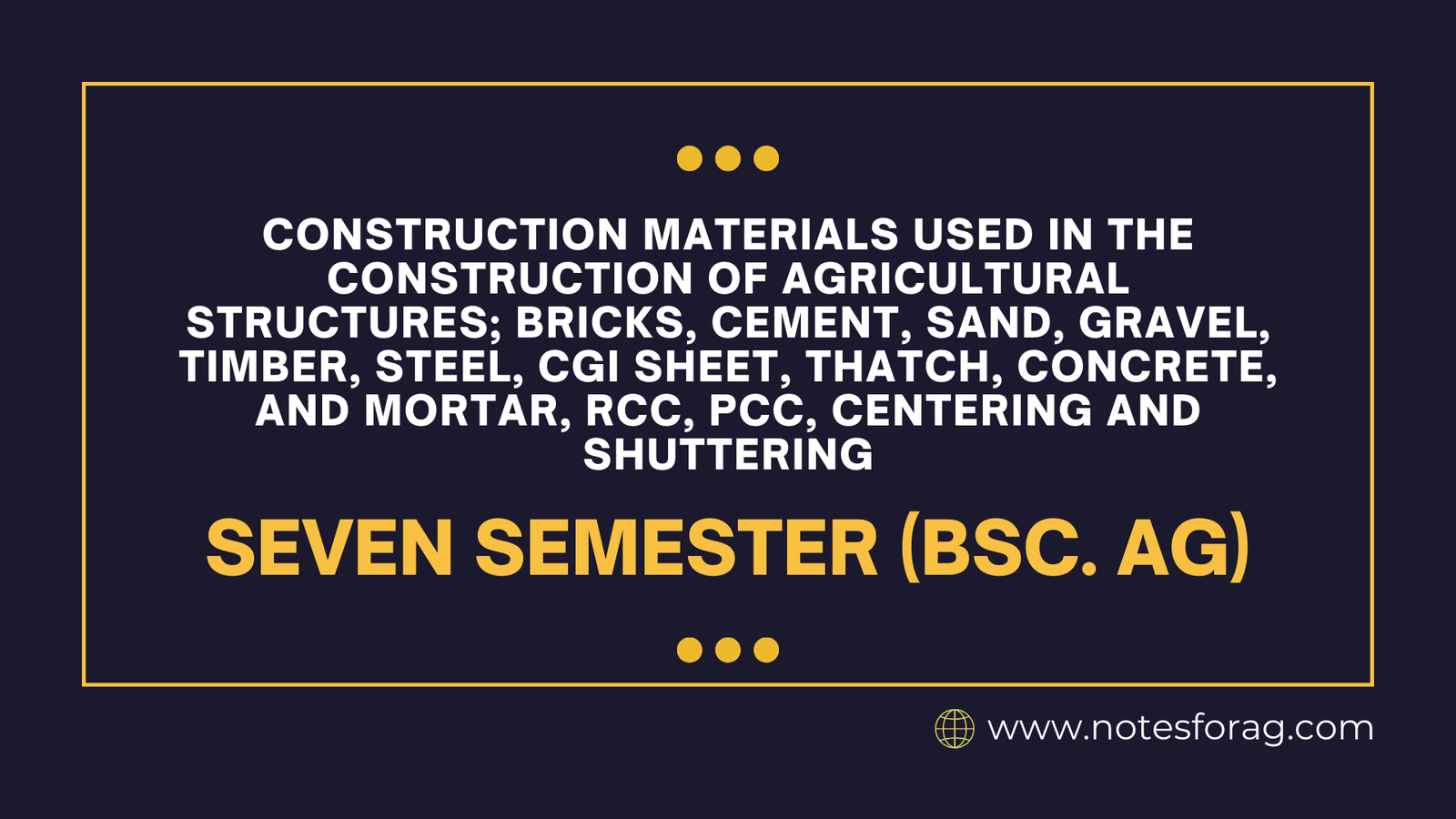Agricultural Structures
Agricultural structures refer to buildings and facilities specifically designed for various farming activities. These structures play a crucial role in supporting agricultural production, storage, processing, and livestock management.
Table of Contents
Agricultural buildings such as barns, greenhouses, silos, and livestock shelters rely on various materials selected for their specific functions and environmental suitability. The choice of materials is essential, affecting durability, cost efficiency, and sustainability. Here’s an in-depth look at the commonly utilized materials in agricultural construction.
1. Bricks

Bricks have long been a staple in building and are widely favored for agricultural structures due to their longevity and thermal properties. They offer excellent insulation, helping to stabilize internal temperatures in barns and storage areas. While clay bricks are the most prevalent, concrete bricks are also popular for their strength and affordability. Brick constructions can endure harsh weather, making them suitable for diverse agricultural applications.
2. Cement
Cement is a key ingredient in concrete, which is widely used in agricultural buildings. It acts as a binder that solidifies over time, providing strength and durability. In agricultural settings, cement is frequently used for foundations, floors, and walls. Its adaptability allows it to be mixed with various aggregates, creating concrete tailored to specific requirements, such as high-strength options for load-bearing areas.
3. Sand
Sand is an essential component in making concrete and mortar, serving as an aggregate that boosts the strength and stability of these materials. In agriculture, sand is often combined with cement to form concrete for floors, walls, and foundational elements. The quality of sand—its grain size and cleanliness—plays a crucial role in the performance of the final product, making careful selection important.
4. Gravel
Gravel is another important aggregate in concrete production, adding bulk and stability. In agricultural contexts, gravel is commonly used for drainage, roadways, and as a base material for various structures. Its permeability is vital for effective water drainage, preventing accumulation around buildings.
5. Timber
Timber is a traditional material that remains popular in agricultural construction for its natural insulation, aesthetic appeal, and ease of handling. Commonly used softwoods, like pine and fir, are utilized for framing, trusses, and roofing. Timber structures can be constructed quickly and often at a lower cost than concrete alternatives. However, it’s essential to treat timber to protect against pests and decay.
6. Steel
Steel is increasingly favored in modern agricultural construction due to its strength, durability, and versatility. It is typically used in the frameworks of larger structures like warehouses and livestock shelters, allowing for expansive spaces without internal supports. Steel is resistant to weather, fire, and pests, making it an excellent choice for agricultural uses. Pre-fabricated steel components can also expedite the construction process.
7. CGI Sheets
Corrugated galvanized iron (CGI) sheets are a popular roofing option for agricultural buildings. They are lightweight, durable, and corrosion-resistant, making them suitable for various weather conditions. CGI sheets effectively protect against rain and snow while promoting good ventilation. They are often combined with timber or steel frameworks for constructing roofs on barns, sheds, and storage buildings.
8. Thatch
Thatching, a traditional roofing method using natural materials such as straw, reeds, or grass, is often found in rural agricultural settings. It provides excellent insulation and visual appeal. Although thatch has a shorter lifespan than modern materials, it can be a sustainable choice when sourced locally. Thatch roofs help maintain internal temperatures, benefiting livestock and crops.
9. Concrete

Concrete is one of the most versatile construction materials available and is extensively used in agricultural structures. It is favored for its compressive strength and durability, commonly utilized for foundations, walls, floors, and silos. Concrete can be poured into various molds, allowing for diverse architectural designs. Reinforced concrete, which includes embedded steel bars, enhances tensile strength, making it suitable for heavy-duty applications.
10. Mortar
Mortar, a mixture of cement, sand, and water, is used to bond bricks, stones, and other materials together. In agricultural construction, mortar is crucial for ensuring the structural stability of walls and other components. The specific mortar mix chosen can influence the overall strength and longevity of a building. Properly mixed and cured mortar prevents water infiltration, which is vital for protecting stored agricultural products.
11. Reinforced Cement Concrete (RCC)
RCC is a composite material combining concrete with steel reinforcement, allowing for the construction of structures that can bear substantial loads and stresses. In agricultural contexts, RCC is commonly employed for foundations, columns, beams, and slabs, especially in larger facilities like warehouses and livestock housing. The combination of steel and concrete enhances overall performance, making RCC a preferred option for many agricultural projects.
12. Plain Cement Concrete (PCC)

PCC is a basic form of concrete used mainly for structural elements such as floors and foundations. It consists of cement, sand, gravel, and water, without steel reinforcement. Although not as strong as RCC, PCC is cost-effective and suitable for less critical applications within agricultural structures.
13. Centering and Shuttering
Centering and shuttering are temporary frameworks used during concrete construction. Centering supports the formwork, while shuttering refers to the molds that shape the concrete as it cures. These systems are crucial for ensuring accurate formation and stability of concrete elements. In agricultural projects, effective centering and shuttering techniques contribute to smoother finishes and precise dimensions in concrete work.
Conclusion
Selecting materials for agricultural structures is influenced by factors such as environmental conditions, intended use, and budget. Understanding the properties and applications of various materials—bricks, cement, sand, gravel, timber, steel, CGI sheets, thatch, concrete, mortar, RCC, PCC, and centering and shuttering—enables farmers and builders to create durable, efficient, and sustainable facilities tailored to their needs. The right combination of materials ensures these structures function effectively while minimizing maintenance and repair costs in the long run.
Frequently Asked Questions (FAQ)
How do greenhouses benefit agriculture?
Greenhouses create controlled environments that protect plants from adverse weather and pests, allowing for year-round cultivation and improved crop yields. They enable farmers to optimize growing conditions for various plants.
What is the purpose of a silo?
A silo is designed to store bulk materials, primarily grains or silage, helping to preserve feed quality and reduce spoilage. They allow for efficient storage and management of large quantities of agricultural products.
Related Articles

